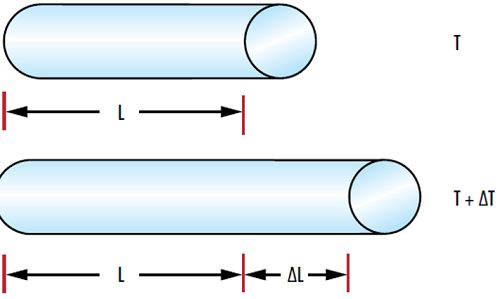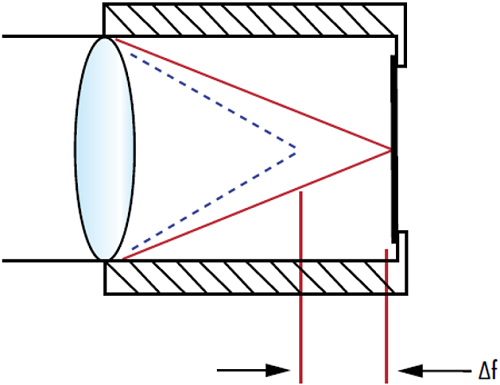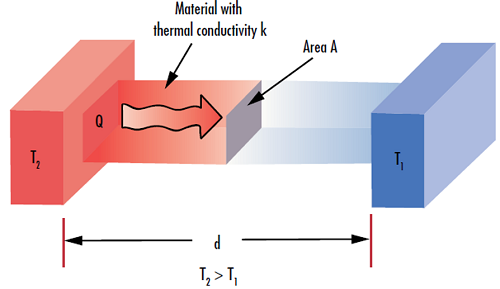光學基板的熱性能
雷射資源指南第8.2,8.3 及 8.4部份。
熱膨脹係數
對於易受溫度變化影響的應用而言,應開發 無熱光學系統 。無熱光學系統對環境熱能變化及其產生的系統失焦並不敏感。開發無熱設計取決於材料的熱膨脹係數 (CTE),以及溫度指數變化 $ \left( \tfrac{\text{d} n}{ \text{d} T} \right) $ 對紅外線領域特別關鍵。
CTE 可衡量溫度變化造成的材料尺寸分數變化。此項熱膨脹定義為:
$ \small{\alpha_{L}}$ 為原始長度, $ \small{L} $ 為長度變化, $ \small{T} $ 為線性 CTE,而 $ \tfrac{\text{d} L}{\text{d} T} $ 為溫度變化 with respect to the $ \small{L} $ dimension.
$ \small{\alpha_{A}}$ is the area CTE, $ \small{A} $ is the area in two dimensions, and $ \tfrac{\text{d} A}{\text{d} T} $ is the reciprocal of the temperature gradient with respect to the area.
$ \small{\alpha_{V}}$ is the volumetric CTE, $ \small{V} $ is the volume in three dimensions, and $ \tfrac{\text{d} V}{\text{d} T} $ is the reciprocal of the temperature gradient with respect to the volume. For isotropic materials including most glass and metal, the relationship between CTEs is shown in Equation 4.
In practice, notably for small temperature changes, the differential terms for the change in length and change in temperature ($\small{\text{d}L}$ and $\small{\text{d}T}$ respectively) are typically well-approximated by differences ($\small{ \Delta L}$ and $\small{ \Delta T}$ respectively) seen in Equation 5.
(5)$$ \alpha_L \approx \frac{1}{L} \frac{\Delta L}{\Delta T} $$
一般來說,物體溫度上升,體積會跟著變大,原因是其中組成分子的動能增加 (圖 1)。不過有一些罕見例外,例如水的溫度與長度之間就具有反向關係;水的 CTE 在 3.983°C 以下時會成為負值,因此溫度低於 3.983°C 時,水的體積會膨脹。

圖 1: 溫度變化 $ \left( \small{ \Delta T \small} \right) $ 會造成材料長度變化 $ \left( \small{ \Delta L} \right) $ 變化依據為材料的熱膨脹係數 (CTE)
CTE 的單位為 $ \tfrac{1}{ ˚ \text{C}}$ or $ \tfrac{1}{ \text{K}}$。選擇適合應用的光學產品時,CTE 是重要的考量因素,因為光學產品大小可能影響元件的對準及應力。在溫度擺盪的環境中,使用者需要瞭解溫度上升時光學產品會膨脹。在室溫環境下為 25mm 的光學產品,到了 300°C 可能變成 25.1mm,可能導致安裝組件破裂,或以不需要的方向變形光線,進而影響指向穩定性及雷射對準;因此一般都希望具有低 CTE
折射指數的溫度係數
折射指數的溫度係數 $ \left( \tfrac{\text{d} n}{\text{d} T} \right) $ ,是衡量折射指數相對於溫度的變化情形。大部分紅外線材料的 $ \tfrac{\text{d} n}{\text{d}T} $ 比可見光玻璃高出好幾倍,對折射指數產生大幅變化。物質密度幾乎一定與溫度呈反向比例關係,亦即材料密度會隨溫度上升而降低,因此折射指數會隨溫度上升而降低。1 When designing athermalized lenses, glasses with both positive and negative temperature coefficients are paired together to balance out the refractive index change of each other.
材料 $ \tfrac{\text{d} n}{\text{d}T} $ 的完整公式為:
其中
$ \small{ T_0 }$ 為參考溫度 (20℃)
$\small{T}$ 為溫度,以 °C 為單位/p>
$\small{\Delta T}$ 為與 $ \left( \small{T} - \small{T_0} \right)$
的溫差
$\small{\lambda}$ 為光線波長
$ \small{D_0, D_1, D_2, E_0, E_1,} $ 及 $ \small{\lambda} _{\small{\text{TK}}} $ 為材料常數
除了因為鍍膜折射指數變化造成的微小效能差異,$ \tfrac{\text{d} n}{\text{d} T} 不影響反射光學產品。不過 $ \tfrac{\text{d} n}{\text{d} T} $ 是穿透光學元件的重要屬性,因為有助於在溫度變化情況下判定其穩定性。高功率雷射光束入射光學元件時,一定會有一些吸收,造成溫度上升;$ \tfrac{\text{d} n}{\text{d} T} $ 可判定這對效能造成多少影響 (圖 2)。

圖 2: 光學元件折射指數與溫度的變化 $ \left( \tfrac{\text{d} n}{\text{d} T} \right) $ 可能造成透鏡焦距偏移 $ \left( \Delta f \right) $, 改變焦點位置
熱傳導性
材料熱傳導性 $ \left( \small{k} \right) $ 用於衡量材料傳導熱能的能力 (圖 3),通常以 $ \tfrac{\text{W}}{ \left( \text{m} \, \cdot \, \text{K} \right)} $ 或 $ \tfrac{\text{Btu}}{\left( \text{hr} \, \cdot \, \text{ft} \, \cdot \, \text{˚F} \right)} $ 為單位量測,用於定義熱傳導率:
$ \small{Q} $ 代表在時間 $ \small{t} $, 期間傳輸熱能的量,而 $ \tfrac{Q}{t} $ 單位為 $ \tfrac{\text{J}}{\text{s}} $, 或 $ \small{\text{W}} $。$ \small{A} $ 是基材的截面面積, $ \small{\Delta T} $ 為材料兩側之間的溫差,而 $ \small{d} $ 為材料厚度。

圖 3: 材料熱傳導性 $ \left( \small{k} \right) $ 定義傳輸熱能 $ \left( \small{Q} \right) $ 通過特定厚度 $ \left( \small{d} \right) $ 的能力
金屬等具備高傳導性的材料,其散熱能力高於玻璃或塑膠等熱導性低的材料。由於雷射輻射穿透光學元件的主要效應之一,就是輻射能會轉換為熱能,因此務必要瞭解材料的熱傳導性,以評估光學元件周圍的能量平衡。不會反射或穿透特定波長的材料,將吸收更多光線,溫度更快上升,例如彩色玻璃及吸收性濾光片。如果光學元件出現熱能以不穩定狀態聚積的情況,很快就會發生損傷,特別是在沒有設置有效冷卻系統的情況下。儘管如此,若光學元件為非同質性,其導熱能力不一致,則材料熱點可能快速且更有效地對元件造成損傷。類似於折射指數的溫度係數,瞭解熱傳導性相當重要,可協助建模高功率雷射系統,以及瞭解預期的光學效能效應。
參考資料
- “TIE-19: Temperature Coefficient of the Refractive Index.” Schott, July 2016.













 上個章節
上個章節 


or view regional numbers
QUOTE TOOL
enter stock numbers to begin
Copyright 2023, Edmund Optics Inc., 14F., No.83, Sec. 4, Wenxin Road, Beitun District , Taichung City 406, Taiwan (R.O.C.)
Privacy Policy | Cookie Policy | Terms & Conditions | Accessibility
California Consumer Privacy Act (CCPA): Do Not Sell My Information